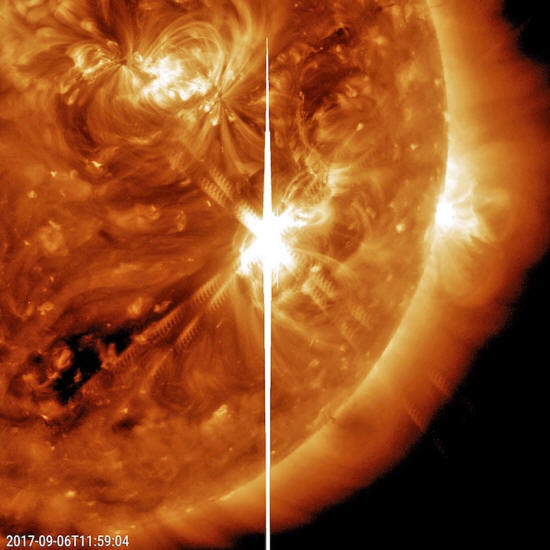|

by Lauren Fuge
07 March
2019
from
CosmosMagazine Website

A coronal mass ejection
captured by NASA's Solar Dynamics Observatory
in
September, 2017.
NASA/SDO
The
genesis of
enormous
explosions on the Sun
has long been a
mystery,
but no more...
An international team of astronomers has untangled new insight into
the birth of coronal mass ejections, the most massive and
destructive explosions from the sun.
In a paper (The
Birth of a Coronal Mass Ejection) published in the
journal Science Advances, a team led by Tingyu Gou
from the University of Science and Technology of China was
able to clearly observe the onset and evolution of a major solar
eruption for the first time.
From a distance the sun seems benevolent and life-giving, but on
closer inspection it is seething with powerful fury. Its outer layer
- the corona - is a hot and wildly energetic place that constantly
sends out streams of charged particles in great gusts of solar wind.
It also emits localized flashes known as flares, as well as enormous
explosions of billions of tons of magnetized plasma called
coronal mass ejections (CMEs).
These eruptions could potentially have a big effect on Earth. CMEs
can damage satellite electronics, kill astronauts on space walks,
and cause magnetic storms that can disrupt electricity grids.
Studying CMEs is key to improving the capability to forecast them,
and yet, for decades, their origin and evolution have remained
elusive.
"The underlying
physics is a disruption of the coronal magnetic field," explains
Bernhard Kliem, co-author on the paper, from the University of
Potsdam in Germany.
Such a disruption allows
an expanding bubble of plasma - a CME - to build up, driving it and
the magnetic field upwards. The "bubble" can tear off and erupt,
often accompanied by solar flares.
The magnetic field lines then fall back and combine with neighboring
lines to form a less-stressed field, creating the beautiful loops
seen in many UV and X-ray images of the sun.
"This breaking and
re-closing process is called magnetic reconnection, and it is of
great interest in plasma physics, astrophysics, and space
physics," says Kliem.
But the reason why the
coronal magnetic field is disturbed at all is a matter of continuing
debate.
"To many, an
instability of the magnetic field is the primary reason," says
Kliem.
"This requires the
magnetic field to form a twisted flux tube, known as magnetic
flux rope, where the energy to be released in the eruption can
be stored."
The theory holds that
turbulence causes the magnetic flux ropes to become tangled and
unstable, and if they suddenly rearrange themselves in the process
of magnetic reconnection, they can release the trapped energy and
trigger a CME.
Others in the field think that it's the other way around - magnetic
reconnection is the trigger that forms the flux rope in the first
place.
It's a tricky question to tease out because flux ropes and
reconnection are so intertwined. Recent studies even suggest that
there's another layer of complexity: smaller magnetic loops called
mini flux ropes, or plasmoids, which continuously form
in a fractal-like fashion and may have a cascading influence on
bigger events like a CME.
To get a better handle on this complex process, the team observed
the evolution of a CME that erupted on May 13, 2013.
By combining
multi-wavelength data from NASA's Solar Dynamics Observatory
(SDO)
with modern analysis techniques, they were able to determine the
correct sequence of events:
that a magnetic
reconnection in the solar corona formed the flux rope, which
then became unstable and erupted.
Specifically, they found
that the CME bubble continuously evolved from mini flux ropes,
bridging the gap between micro- and macro-scale dynamics and thus
illuminating a complete evolutionary path of CMEs.
The next step, Bernhard Kliem says, is to understand another
important phenomenon in the eruption process:
a thin, elongated
structure known as a "current sheet", in which the mini flux
ropes were formed.
"We need to study
when and where the coronal magnetic field forms such current
sheets that can build up a flux rope, which then, in turn,
can erupt to drive a solar eruption," he concludes.
| 

